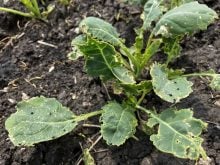Judging a herbicide by its label can sometimes be as difficult as judging a book by its cover, especially if you’re reading product labels on your tiny smartphone screen.
The Pest Management Regulatory Agency database on labels comprises PDFs, which are often difficult to use when projected on a small screen.
However, labels are the law. If it’s difficult to understand labels and find information on them, you could unwittingly be breaking the law, says Tom Wolf, owner of Agrimetrix.
“Outdated or impractical information on labels creates disrespect. Since labels are documents enforceable by federal law, applicators want to comply. At this time they can’t comply, and probably shouldn’t, if they want to do the job right,” Wolf said.
Read Also

Growing garlic by the thousands in Manitoba
Grower holds a planting party day every fall as a crowd gathers to help put 28,000 plants, and sometimes more, into theground
He and his Sprayer101.com partner, Jason Deveau, have taken the first steps in developing a system of label summary sheets and universal icons that will cover some aspects of labels.
“The fact is that our equipment and chemistry technology have evolved far quicker than our labels. With our current system, the application information you need must be published in the label, but it might be hidden on page 23,” he said.
“The idea Jason and I had was to create a standardized usable document or a label summary sheet that has legal status. The 17 icons in those three sections might form the basis of an internationally adapted icon herbicide labeling system. The buy-in has to be with the registrants and regulators.”
When asked if he sees a path for these icons to eventually be incorporated into ISO standards, Wolf said it’s conceivable the all-Canadian project might spread to the United States and ultimately to the world regulating body.
“We’ve made presentations to the American Society of Ag and Bioresearch Engineers and Crop Life Canada. Ultimately it would require a new approach to treating labels. Right now, labels are essentially Word documents. There are slight formatting and terminology differences from company to company and label to label,” he said.
“I read a lot of labels in a year. I enjoy reading labels, to be quite honest. They are interesting. The grey area is that we all know some of the information is not up to date. Much of the problem is precedence. The application language on the label has already gone through a regulatory approval before, so why rock the boat.”
Wolf said he and Deveau are not the only people looking at how labels can be improved. PMRA and Crop Life Canada support the project to standardize and simplify some aspects of the label.
He said much of the basic information is contained in sprayers101.com/label_1/ and sprayers101.com/label_2/.
Wolf and Deveau have established the following nine criteria for what they consider to be a good label:
- Place the information that applicators need at the top.
- Update regularly to reflect modern practice and advice.
- Help new applicator figure out how to apply product with any equipment.
- Identify spray quality that offers good coverage and low drift.
- Reference research that supports variations in the application guidelines.
- Available electronically and readable on a mobile device, but not on a PDF.
- Protect environment and bystanders, foster better pesticide performance.
- Label is easy to generate.
- Label would be read by applicators.
According to Sprayers101.com, necessary information is often difficult to locate, obsolete, contradictory, subjective or even missing from the label. A consistent, concise and clear format that summarizes critical content is needed to truly encourage an applicator to read and follow the label.
Wolf and Deveau worked with growers, universities, industry and government extension to develop the prototype label summary sheet. Wolf emphasized that it does not replace or interpret the current label. It is a summary intended to accompany the label.
He said some chemical companies already recognize this need and have developed short documents to summarize key aspects of the label. However, these are inconsistent and brand-specific marketing documents that do not always contain the required information.

















